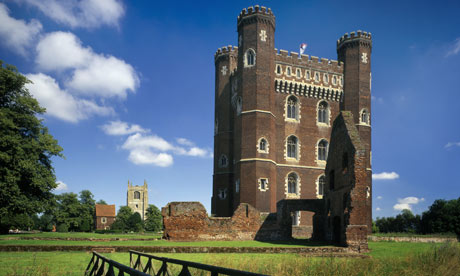Among the most surprising buildings to find in the English landscape is Tattershall Castle, which shoots up straight from the vegetable flatlands of Lincolnshire and could easily be mistaken for a period reproduction, looking new and almost too castle-like, more like a Victorian fancy than a defensible tower built in the 15th century from 7 million well-laid bricks. Tattershall is less well-known than it might be, but it has an important place in the national story – of Scotland and Wales as well as England. A little over 100 years ago, its fate prompted a fuss that led to the British state's decisive involvement in what we now know as the heritage industry, with consequences for planning legislation and Britain's understanding of its past that continue today, and will be remembered this year in a series of exhibitions and television programmes marking the centenary of the Ancient Monuments Act.
Briefly, the story goes like this. Between 1430 and 1450, Tattershall was built for Ralph Cromwell, Lord Treasurer of England, and then changed hands among various grand English families over the next four centuries until, after it had fallen into disrepair and neglect, American speculators bought it in 1911. This was America's gilded age – railroad millionaires and press magnates were hungry to import the arts and crafts of old Europe, to be displayed in their new palaces: paintings, sculpture and tapestries of course, but also gargoyles, Norman arches and, in Tattershall's case, fireplaces – the very ones that Pugin had used as his model for those in the Houses of Parliament. Several were ripped out and carried off, presumably to begin their journey to the docks. There were even reports that the castle itself would be dismantled and shipped across the Atlantic, prefiguring the actual fate of London Bridge 50 years later.
It would be wrong to say that all of this caused widespread outrage. The idea that buildings contained a nation's history and identity had still to be popularised; until 1890, British (that is, largely English) history hardly featured in the teaching of ordinary schools. The Marquess Curzon of Kedleston, however, wasn't ordinary. He was a visionary imperialist in the high summer of empire. As viceroy, he'd ruled India energetically, controversially and sometimes detestably; back in England, lacking a proper political job, he fulfilled his passions for history and country houses. For him, the story of a house was "as enthralling as that of an individual". His biographer, David Gilmour, wrote that he "was almost incapable of owning or inhabiting a piece of property without attempting to write a book about it".
Britain could hardly maintain its rightful place in the world if it was flogging 15th-century forts and their enthralling stories to Americans. Curzon, learning that Tattershall's fate would be sealed the next day, sped to Lincolnshire, inspected the castle and offered a price the Americans couldn't refuse. The fireplaces came back to the castle on horse-drawn carts, where they lay wrapped in union flags like the coffins of war heroes being borne home on a bier. Later, when Curzon bequeathed Tattershall to the nation (in the shape of the National Trust), he wrote that beautiful and ancient buildings were not only historical documents of supreme value, "but are a part of the spiritual and aesthetic heritage of a nation, imbuing it with reverence and educating its taste".
These sentiments are now so worn with use – the philosophy on which so many school excursions and helicopter-shot documentaries of Britain are founded – that it's hard to imagine they were ever fresh. And yet, for most of Victoria's reign, new houses, railways and factories pushed ancient streets and inns out of the way with very little objection other than from the occupiers. The cult of preservation grew around objects related to the famous – Nelson's Victory and the cottages of Anne Hathaway and Robert Burns – extending, as the century wore on, to medieval churches and prehistoric monuments. In 1882, the last group got their own legislation, the first Ancient Monuments Act, which encouraged landowners to place in government care any neolithic burial chambers or stone circles they had on their property. But there was no compulsion. A landowner could act as he liked, and many monuments went on being destroyed, including some cup-marked stones at Ilkley in Yorkshire which were carted off "probably to some rockery", in the words of the government inspector who helplessly watched their departure.
Could the state tell property owners how to treat their property? The idea went against every notion of free-born Englishness and individual rights, and was especially obnoxious to the Tory gentry, because preservation and conservation were then broadly "socialist" causes. But here Curzon the imperialist was unexpectedly radical. During his years as viceroy, he'd re-energised the care of India's glorious monuments by strengthening the archaeological department, boosting its repair budget and enacting legislation that gave the government control over the most important parts of the country's built heritage whether or not they were in private ownership. The Taj Mahal's restoration was especially rewarding: "If I had done nothing else in India," he told his wife, "I have written my name here, and the letters are a living joy."
With the Tattershall case, he saw a paradox. To quote from a speech made this week by English Heritage chief Simon Thurley, it distressed Curzon that the law could stop architectural looters in Punjab but not in Lincolnshire. Tattershall's last-minute rescue alerted inquiries that showed many valuable sites were being damaged, triggering parliamentary calls for legislation that had Curzon's influential support. So the ancient monuments consolidation and amendment bill passed into law in 1913, and out of it came the mechanics of conservation – preservation orders and scheduling – that still persist. For the first time in matters of aesthetics and architecture, the state constrained the behaviour of the property-owning class.
The story has two ironies. The first is that Curzon stopped Tattershall castle's export to America with American money, provided by the estate of his late millionaire father-in-law, Levi Leiter, who co-founded the Marshall Field department store in Chicago. Without this regular income, which by 1914 was giving the former viceroy £40,000 a year in spending money, he would never have afforded his London mansion and three country estates.The second, more important irony could be summed up in three words: the present government. Or in two: Michael Gove. How lucky they are, with their stress on the educational and civic importance of national history, that so much of it was so well preserved by the state funding and organisation of the Ministry of Works, its responsibilities in England now inherited by English Heritage. Without the intervention of the state – the big, law-making state poking its nose where the Duke of Rutland believed it shouldn't – where would these monuments have been? Some demolished, some in ruins, some with metal-framed windows, and some no doubt in the US.
• This article was amended on 12 February 2013 because the original said Tattershall Castle was built from 700,000 bricks. The National Trust say that while they don't have a definitive answer, they believe 7 million bricks is a more likely number.








